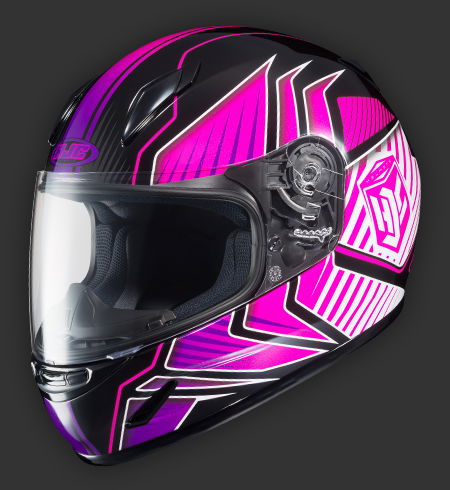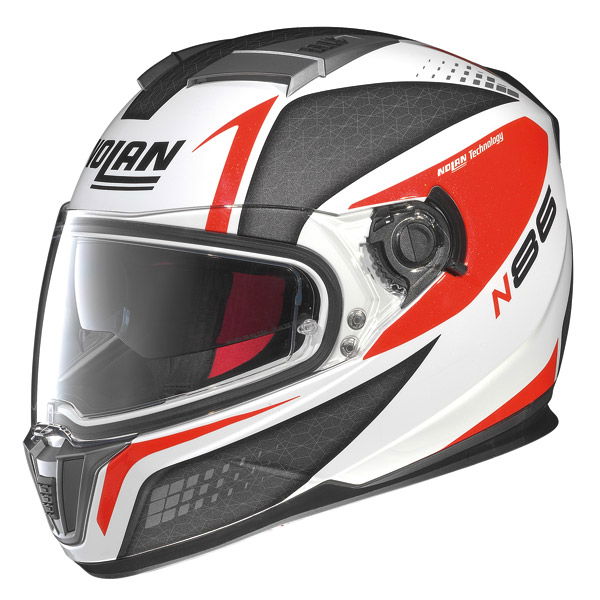SR1 review
The SR1 is a sport helmet which has been developed for optimum performance on the race track

High-performance aerodynamics
The SR1 is a sport helmet which has been developed for optimum performance on the racetrack. Thanks to its advanced aerodynamics the helmet is at all times stable in the wind and even at high speeds creates no upward lift.
- Aerodynamic shape
- Upward lift = 0!
- Directionally stable
- No oscillatory tendency
- No buffeting
- The D-Force spoiler enables the SR1 to be adjusted to the riding posture in such a manner that ideal behaviour of the helmet in the air flow is guaranteed at all times. 2 positions with different setting angles are available.
Acoustics
Aeroacoustics of the SR1
All SCHUBERTH motorcycle and racing helmets are developed and optimised under scientific conditions in the SCHUBERTH wind tunnel. The reduced noise level assists the rider's concentration and attentiveness.
- Quiet helmet thanks to anti-noise technology
- Installation of a wind deflector enables the aeroacoustics and consequently the noise level to be improved still further.
- Only 88dB(A) at 100 km per hour (with closed machines)
Basics
Sound intensity is a phenomenon which can be explained logarithmically/mathematically. A 10 dB(A) jump in noise level is perceived by the human ear as a doubling of the noise level. Conversely a drop of 10 dB(A) is perceived as a halving of the noise level. Physically these changes in the perceived noise level already occur at an increase or decrease of 6 dB (A). This means that the increase/decrease in the physical load is higher than the one perceived.
Optimisation
Aeroacoustics are influenced by:
- the position of the helmet in the air flow, depending on the driver's size, riding posture, the motorcycle's fairing
- The fit of the helmet: differences in the anatomy of the wearer's head, neck and shoulder areas
Tips
- use a special wind deflector
- change the position of the windscreen
- close the gap at the bottom of the helmet, e.g. using a scarf
Ventilation
Ventilation at Formula 1 level.
The Proactive Dynamic Ventilation System developed specially for the SR1 can be set as required using controls in the chin and head areas. Depending on the riding posture and speed, the intensity of the ventilation can also be varied. A sporty riding posture permits maximum fresh air supply.
- Visor vent to reduce the fogging tendency
- 2 head ventilation inlets (adjustable)
- 2-way chin vent for targeted distribution of the incoming air in the helmet
Effect
The highly effective Proactive Dynamic Ventilation System of the SR1.
- 3-way chin vent
- Variable pad system
- Visor vent
- Head vent
- Ventilation and cooling of the cheek pads
- Active air extraction system
O2 ventilation
- In cold weather it often occurs that with closed air supply the motorcyclist's neck zone becomes sealed off by hoods, scarves or neckerchiefs.
- The concentration of carbon dioxide inside the helmet is a key safety criterion for preventing symptoms of fatigue and the thinning of breathable air.
- No negative effects on health need be feared as long as the CO2 concentration remains below 3.5 %.
- The maximum level of CO2 concentration at the workplace is 0.5 %
- Even when the neck zone is sealed off by hoods, scarves or neckerchiefs, this helmet guarantees that the CO2 concentration remains below the 0.5% limit as from a speed of approx. 30 km/h.
- In cases where the helmet is completely sealed off by hoods, scarves or neckerchiefs, the visor ought to be opened (city-travel position) for safety reasons when idling, for example at traffic lights, or travelling slowly.
High-performance aerodynamics
The SR1 is a sport helmet which has been developed for optimum performance on the racetrack. Thanks to its advanced aerodynamics the helmet is at all times stable in the wind and even at high speeds creates no upward lift.
- Aerodynamic shape
- Upward lift = 0!
- Directionally stable
- No oscillatory tendency
- No buffeting
- The D-Force spoiler enables the SR1 to be adjusted to the riding posture in such a manner that ideal behaviour of the helmet in the air flow is guaranteed at all times. 2 positions with different setting angles are available.
Acoustics
Aeroacoustics of the SR1
All SCHUBERTH motorcycle and racing helmets are developed and optimised under scientific conditions in the SCHUBERTH wind tunnel. The reduced noise level assists the rider's concentration and attentiveness.
- Quiet helmet thanks to anti-noise technology
- Installation of a wind deflector enables the aeroacoustics and consequently the noise level to be improved still further.
- Only 88dB(A) at 100 km per hour (with closed machines)
Basics
Sound intensity is a phenomenon which can be explained logarithmically/mathematically. A 10 dB(A) jump in noise level is perceived by the human ear as a doubling of the noise level. Conversely a drop of 10 dB(A) is perceived as a halving of the noise level. Physically these changes in the perceived noise level already occur at an increase or decrease of 6 dB (A). This means that the increase/decrease in the physical load is higher than the one perceived.
Optimisation
Aeroacoustics are influenced by:
- the position of the helmet in the air flow, depending on the driver's size, riding posture, the motorcycle's fairing
- The fit of the helmet: differences in the anatomy of the wearer's head, neck and shoulder areas
Tips
- use a special wind deflector
- change the position of the windscreen
- close the gap at the bottom of the helmet, e.g. using a scarf
Ventilation
Ventilation at Formula 1 level.
The Proactive Dynamic Ventilation System developed specially for the SR1 can be set as required using controls in the chin and head areas. Depending on the riding posture and speed, the intensity of the ventilation can also be varied. A sporty riding posture permits maximum fresh air supply.
- Visor vent to reduce the fogging tendency
- 2 head ventilation inlets (adjustable)
- 2-way chin vent for targeted distribution of the incoming air in the helmet
Effect
The highly effective Proactive Dynamic Ventilation System of the SR1.
- 3-way chin vent
- Variable pad system
- Visor vent
- Head vent
- Ventilation and cooling of the cheek pads
- Active air extraction system
O2 ventilation
- In cold weather it often occurs that with closed air supply the motorcyclist's neck zone becomes sealed off by hoods, scarves or neckerchiefs.
- The concentration of carbon dioxide inside the helmet is a key safety criterion for preventing symptoms of fatigue and the thinning of breathable air.
- No negative effects on health need be feared as long as the CO2 concentration remains below 3.5 %.
- The maximum level of CO2 concentration at the workplace is 0.5 %
- Even when the neck zone is sealed off by hoods, scarves or neckerchiefs, this helmet guarantees that the CO2 concentration remains below the 0.5% limit as from a speed of approx. 30 km/h.
- In cases where the helmet is completely sealed off by hoods, scarves or neckerchiefs, the visor ought to be opened (city-travel position) for safety reasons when idling, for example at traffic lights, or travelling slowly.

